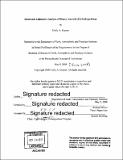Rotational lightcurve analysis of binary Asteroid (22) Kalliope/Linus
Author(s)
Kramer, Emily Anne
DownloadFull printable version (2.422Mb)
Other Contributors
Massachusetts Institute of Technology. Department of Earth, Atmospheric, and Planetary Sciences.
Advisor
Richard Binzel.
Terms of use
Metadata
Show full item recordAbstract
Binary asteroids have been insightful to scientists in recent years in their quest to better understand the Solar System in its early stage. Observing a mutual event between a primary and its moon can yield the sizes of the objects in units of the semi-major axis a. When the linear dimensions of the orbit can be known, Kepler's Third Law allows for a solution of the mass. As an example, because the absolute linear scale of (22) Kalliope/Linus is known [1], one can determine the component sizes and reduce error bars on the mass and density of this M-type asteroid. Since the bulk composition is known from spectral data, the porosity of the asteroid can be calculated. Knowing the porosity of the asteroid can give scientists a better understanding of its formation and dynamical evolution. Binary object (22) Kalliope/Linus is a classic example of a system for which this technique can yield valuable results. An observing campaign involving five observers resulted in twenty-eight nights of data. The data were used to create rotational lightcurves, which were scanned for signatures of mutual events.
Description
Thesis: S.B., Massachusetts Institute of Technology, Department of Earth, Atmospheric, and Planetary Sciences, 2008. Cataloged from PDF version of thesis. Includes bibliographical references (page 34).
Date issued
2008Department
Massachusetts Institute of Technology. Department of Earth, Atmospheric, and Planetary SciencesPublisher
Massachusetts Institute of Technology
Keywords
Earth, Atmospheric, and Planetary Sciences.